Facebook has built a reputation for being notoriously insecure, taking payments from attackers with little to no concern for the safety of its users; but a pattern of neglect for information security is not exactly the issue when a finance guy in Sydney, Australia gives a shout-out to a Facebook user for what he calls an “amazing shot” in history:
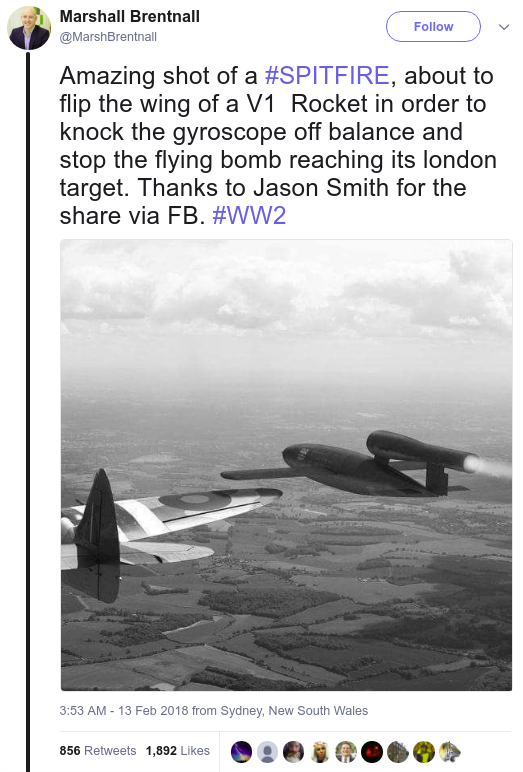
As anyone hopefully can see, this is a fake image. Here are some immediate clues:
- Clarity. What photographic device in this timeframe would have such an aperture let alone resolution?
- Realism. The rocket exhaust, markings, ground detail…all too “clean” to be real. That exhaust in particular is an eyesore
- Positioning. Spitfire velocity and turbulence relative to V1 is questionable, so such a deep wing-over-wing overlap in steady formation is very unlikely
- Vantage point. Given positioning issue, photographer close position aft of Spitfire even less likely
That’s only a quick list to make a solid point this is a fabrication anyone should be able to discount at first glance. In short, when I see someone say they found an amazing story or image on Facebook there’s a very high chance it’s toxic content meant to deceive and harm, much in the same way tabloid stands in grocery stores used to operate. Entertainment and attacks should be treated as such, not as realism or useful reporting.
Now let’s dig a little deeper.
In 2013 an “IAF Veteran” posted a shot of a Spitfire tipping a V1.
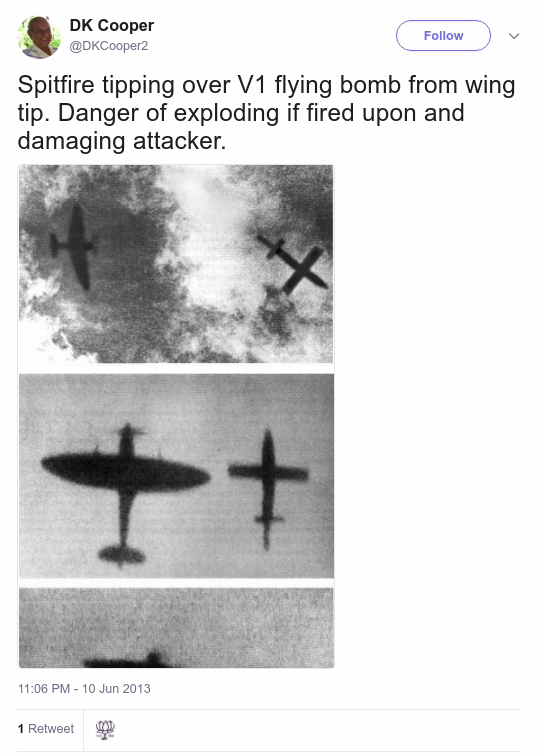
This passes many of the obvious tests above. He also inserts concern about dangers of firing bullets and reliably blowing up a V1 in air, far away from civilians, versus sending it unpredictably to ground. Ignore that misleading analysis (shooting always remained the default) and revel instead in authentic combat photo quality of that time.
After this 2013 tweet several years then pass by, and nobody talks about V1 tipping, until only a few weeks ago a “Military aviation art” account posts a computer rendered image with a brief comment:
Part of a new work depicting the first tipping of a V-1 flying bomb with a wing tip. Who achieved this?
It is a shame this artist’s tweet wasn’t given proper and full credit by the Sydney finance guy, as it would have made far more sense to have a link to the artist talking about their “new work” or even to their art gallery and exact release dates:
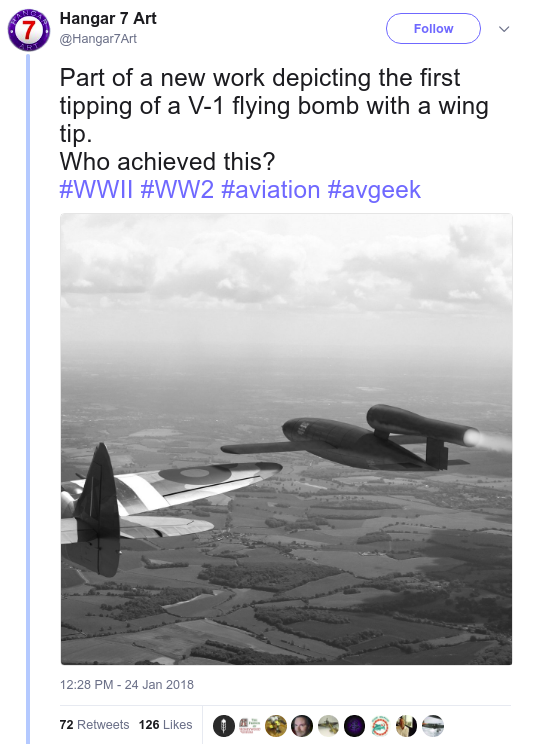
Who achieved this? Who indeed? The artist actually answered their own question in their very next tweet, where they wrote…
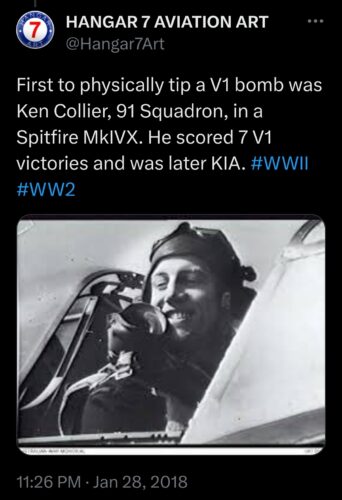
On the bright side the artist answers their own question with some real history and a real photo, worth researching further. On the dark side the artist’s answer also sadly omits any link to original source or reference material, let alone the (attempted) realism found above in that “IAF veteran” tweet with an actual photograph.
The artist simply says it is based on a real event, and leaves out the actual photograph (perhaps to avoid acknowledging the blurry inspiration to their art) while including a high-resolution portrait photo of the pilot who achieved it.
Kind of misleading to have that high-resolution photograph of Ken Collier sitting on the ground, instead of one like the IAF Veteran tweeted… an actual photograph of a V1 being intercepted (e.g. Imperial War Museum CH16281).
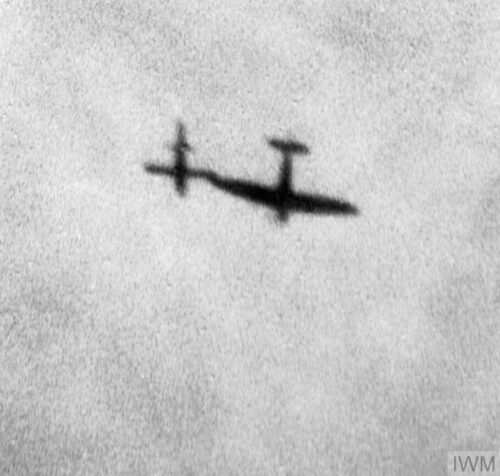
The more complete details of this story not only are worth telling, they put the artist’s high-resolution fantasy reconstruction (of the original grainy blotchy image) into proper context.
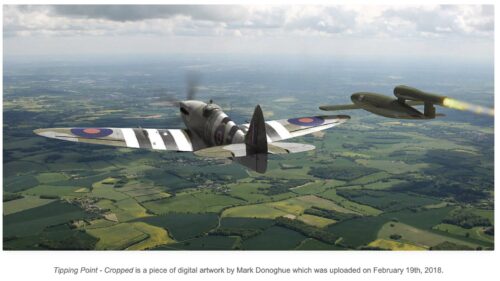
Fortunately “V1 Flying Bomb Aces by Andrew Thomas” is also online and tells us through first-person accounts of a squadron diary what really happened (notice both original photographs are put together in this book, the plane and the pilot).
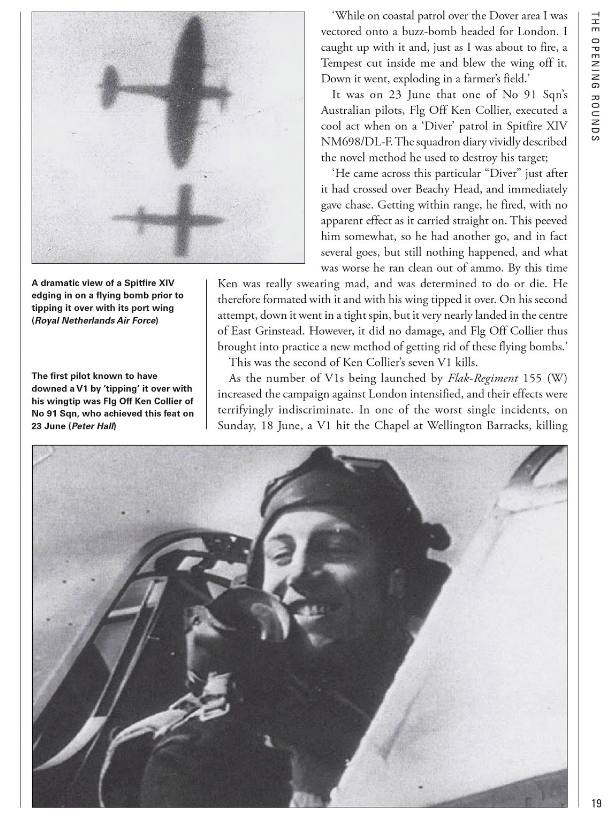
And for another example, here’s what a Vickers staged publicity photo of a Spitfire looked like from that period.
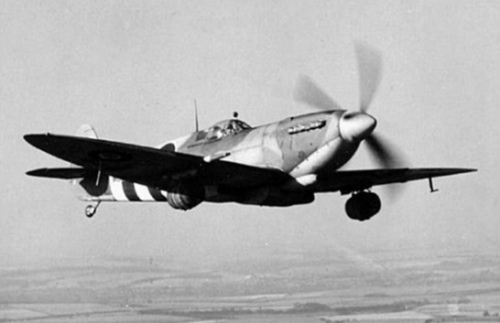
It shows the “Mod XXX Depth Charge” configuration (two 18 gallon barrels of bitter “beer bombs” to deliver into Normandy) and you can be sure an advertising/propaganda agency would have used the clearest resolution possible — the British don’t mess around with their beer technology.
Again notice the difference between air and ground photos, even when both are carefully planned and staged for maximum clarity.
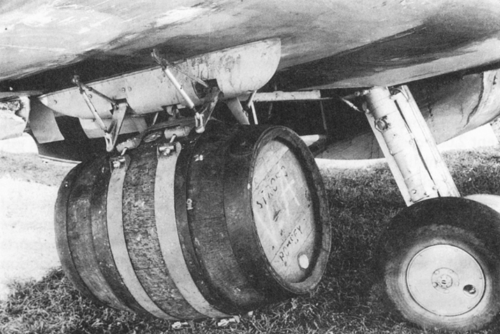
Back to the point here, V1 would be shot down in normal operations not “tipped”, as described below in a Popular Mechanics article about hundreds in 1944 being destroyed by the Tempest’s 22mm cannon configuration.
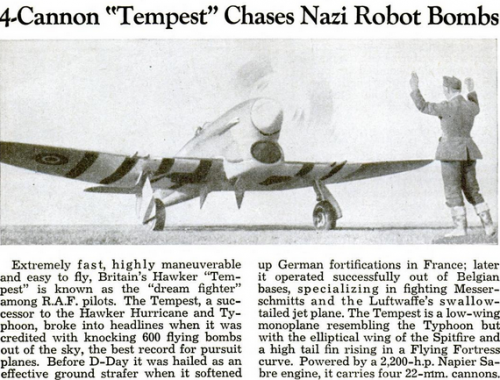
Just to make it absolutely clear — Popular Mechanics’ details about cannons unfortunately doesn’t explain shooting versus tipping — here’s a log from Ace pilots who downed V1.
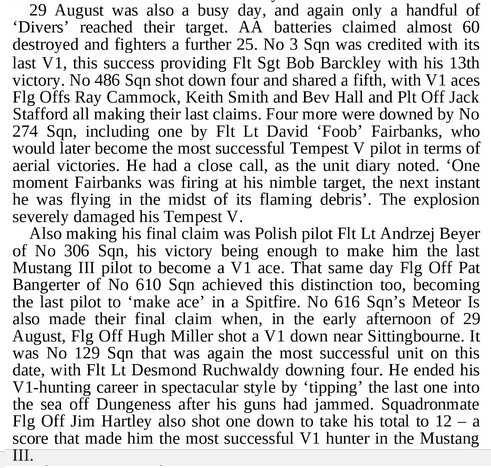
So you can see how debris after explosions was a known risk to be avoided, even leading to gun modifications to hit with longer-ranges. It also characterizes tipping as so unusual and low frequency it would come mainly at an end of a run (e.g. with gun jammed).
Just for a quick aside for what followed soon after WWII ended, as I wrote on this blog last year, things inverted — shooting drones down in the 1950s was far more dangerous than tipping them because of increased firepower used (missiles).
Compared to shooting cannons at the V1, shooting missiles at drones was more like launching a bunch of V1s to hit a bigger V1, which ended as badly as it sounds (lots of collateral ground damage).
Again, the book “V1 Flying Bomb Aces” confirms specific ranges in the 1940s were used for shooting bombs so they exploded in air without causing harm, preferred against tipping.
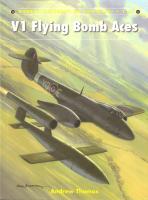
ISBN 9781780962924
…the proper range to engage the V1 with guns was 200-250 yards.
Further out and the attacker would only damage the control surfaces, causing the V1 to crash and possibly cause civilian casualties upon impact.
Any closer and the explosion from hitting the V1’s warhead could damage or destroy the attacking aircraft.
Apparently the reason tipping worked at all was the poorly engineered Nazi technology had a gyro stabilizer for two dimensions only — flight control lacked roll movement.
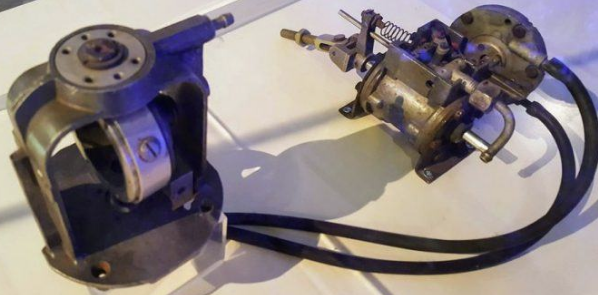
Tipping technically and scientifically really was a dangerous option, because physics would send the bomb out of control to explode on something unpredictable.
Back to the curious case of the artist rendering that started this blog post, it was a Spitfire pilot who found himself firing until out of ammo. He became frustrated without ammo so in a moment of urgency decided to tip a wing of the V1.
Only because he ran out of bullets, in a rare moment, did he decide to tip… of course later there would be others who used the desperate move, but the total number of V1 tipped this way reached barely the dozens, versus the thousands destroyed by gunfire.
Shooting the V1 always was preferred, as it would explode in air and kill far fewer than being tipped to explode on ground as also documented in detail by Meteor pilots, hoping to match the low-altitude high-speed of a V1.
Compared with the high performance piston-engined fighters then in service with the RAF (the Tempest V and Spitfire XIV), the Meteor offered little in the way of superior performance. Where it excelled, however, was at low level – exactly where the V1 operated. The Meteor I was faster than any of its contemporaries at such altitudes. This was just as well, for the V1 boasted an average speed of roughly 400mph between 1,000ft and 3,000ft. At those heights the Tempest V and Spitfire XIV could make 405mph and 396mph, respectively, using 150-octane fuel. The Meteor, on the other hand, had a top speed of 410mph at sea level. […] While the first V1 to be brought down by a Meteor was not shot down by cannon fire, the remaining 11 credited to No. 616 Sqn were, using the Meteor I’s quartet of nose-mounted 20mm cannons.
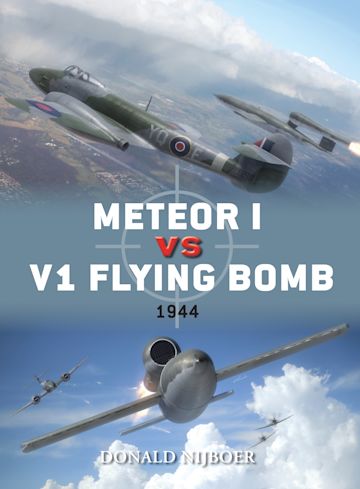
Does a finance guy in Sydney feel accountable for claiming a real event instead of admitting to an artist’s fantasy image?
Of course not, because he has been responding to people that he thinks it still is a fine representation of a likely event (it isn’t) and he doesn’t measure any harm from confusion caused; he believes harm he has done still doesn’t justify him making a correction.
Was he wrong to misrepresent and should he delete his “amazing shot” tweet and replace with one that says amazing artwork or new rendering? Yes, it would be the sensible thing if he cares about history and accuracy, but the real question is centered around the economics of why he won’t change.
Despite being repeatedly made aware that he has become a source of misinformation, the cost of losing “likes” probably weighs heavier on him than the cost of having a low integrity profile. And as I said at the start of this post (and have warned since at least 2009 when I deleted my profile), the real lesson here is that Facebook loves low-integrity people.
Well, while that photo may be a fake, we have [examples of random people editing wikipedia too]
Whomever wrote this has zero knowledge of air combat. Interfering with the wing of the flying bomb spun the gyro out of sync, and flew the bomb into the ground…ostensibly in a non populated area. Pilots were trained to do this…without damaging their flight surfaces. Within six inches was enough…which leads me to believe this was a training photo. The gyro would compensate for the reduced lift on the affected wing, then when the plane withdrew, it would overcompensate, sending the V1 into an unrecoverable spin.
Hi @Ryan. Your statement “leads me to believe this was a training photo” doesn’t follow logically from any of your prior sentences.
Don’t lose sight of the fact that because a thing happened, it does not in any way make an artist rendition of that thing an actual photograph of it. If I paint a tree, just because trees do exist doesn’t make a painting the same thing as a photograph of an actual tree.
I have proven not only that the image is a fake, produced by an artist, I have shown you the original image from the artist where they admit to making it up. For you to say you believe a fake is a real photo…is just icing on the cake of why this blog post was written.
Also while you compliment me for having “zero knowledge” I can assure you my familiarity with Japanese planes is not nearly as good as British and American.
here you can read the official story of the 1st Pilot to do this, RAF Pilot Ken Collier, https://www.awm.gov.au/collection/C2075972
Looking in to RAF records and talking to veterans.
There was no training or any orde given to tip over these bombes. Some attempts where success full but also very stupid. An RAF vet explain that he only knew 6 attempts where made. He said most spitfire couldn’t keep up long enough.
They had to dive to the v1 to get it like wise for the mustang.
That’s why typhoons and or tempest and meteor jets got the task to hunt them and shoot them.
So not training and or order to tip over these bombes.
My dad was a Texas yank in the RAF squadren 71. He soloed at 16 in 1027 on a curtis jenny and was quite old for a figher pilot in 1940.
I asked him about the buzz bombs and he said they would tip the wings throwing off the gyro. He didn’t say they actually touched the wings so if they just did by disrupting air flow wasn’t explained.
LOL, training photo. Here is the un-de-saturated, un-cropped CG original from the artist.
https://twitter.com/hangar7art/status/965677773283979264
Old Pupils attending my old boarding school in Kent in mid 1940s saw V-1s coming over & being shot down or knocked down .
Four V-1s actually crashed into the parish the school was located in – one in the woods on the school grounds .
Even in the 1980s when I attended , we were still pulling bits of metal out of the earth & clay near the stream that ran through it .
Another was seen spiralling down after being tipped by a what observer thought was a Tempest .
(Had a long conversation with him when he visited in Summer of 1988 , as he had been housed in same attic dorm I was presently in)
A V-1 was on trolley as a display at local Headcorn Aerodrome .
Watching a DVD about the Tempest in W.W.II, one of the pilots said that they had been informed that the Germans had rigged the V-1 in such a way that tipping it would cause it to explode straight away, anyone know if this was true or not?